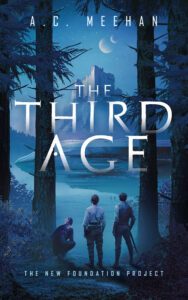When I dreamed of being an author as a kid, digital publishing was a few decades away. As I saw it, there was “real” publishing, and there was “vanity” publishing—either a publisher paid a writer, or a writer paid a publisher. I thought it was a question of being “good enough” to find a publisher, so if I didn’t find an agent and sell my manuscript to someone else to turn into a book, it wouldn’t count. There’s a validation that comes from the traditional publishing process that I thought I needed.
My brother was the first to encourage me to consider independent publishing, and I didn’t want to hear it at first. I wanted to find an agent for A Signal for Redemption. I did my homework and started learning how to find and approach agents who might be open to my manuscript. I even sent a few query letters, only one of which got any response at all. As I was trying to figure out how to do it the right way, I started getting discouraged by the way “the market” seemed to drive everything. I was told to research and follow agents on Twitter to see what they were looking for, which already put me on the wrong foot. I had a manuscript I believed in, but it didn’t match anybody’s tweet. So I started to think about going independent, and eventually decided to try it.
Now, a year and a half after publishing on Amazon, I have a different perspective. There are certainly some disadvantages to the indie route, and yes, I still feel a little pang when I hear about other first-time authors getting a book deal. But when I reflect on the tradeoffs, I feel like the indie route was the right path for me. For me, it is the answer for authenticity, risk, and impatience.
Indie authors have more creative license
I love that my book is my book. People have different tastes, different styles, different standards, and even if another writer had the exact same story to work with, it would be written differently. I imagine working with a publisher would involve give and take with their market-informed tastes, styles, and standards—and their opinions would have the weight of their investment behind them. As an indie author, every aspect of the book, from punctuation to cover art, reflects my decisions. I’m not saying all my decisions have been right, and I have no first-hand knowledge of what decisions authors get to make when working with publishers. What I do know is that I didn’t have to argue or persuade or concede on anything. There’s something deeply rewarding about owning the whole creative package. Good, bad, or indifferent, it is one hundred percent the way I’ve chosen it to be.
I know the traditional path works—the publishers know what they’re doing. I understand how following that set of rules can help an author succeed. I just don’t think it’s the only way to be successful, and of course it also depends on the definition of success. I value the fact that as an indie author, it’s my option to “write to the market” or not. Of course I want the book to do well and hopefully be enjoyed by lots of readers, but no one will lose their job if my book doesn’t sell. So I don’t have to meet anybody else’s requirements.
Indie authors choose the financial risks they are comfortable with
The idea of getting a check from a publisher sounds wonderful, but an “advance” is just that—it’s placeholder money, a bet that a certain number of books sell. If they don’t, the money goes back to the publisher. With indie publishing—especially in the on-demand world—you spend the the money upfront and you pay yourself back with sales. Getting a professional cover, a good layout, buying ISBNs, marketing, and so on can be expensive, but I get to choose where to place my bets. Of course, doing it this way is part of why I’m keeping my day job.
I earn about 21% of each paperback I sell on Amazon, after Amazon takes their cut and the printing costs come out. Not a great get-rich-quick scheme, but better than it could be. Traditionally published, royalties would be more like 7% for a trade paperback, and about 5% for mass-market, though the author doesn’t have those upfront costs so it may come out the same in the end for all but the bestsellers. Someone pays for production, marketing, and distribution, and the author’s profit is whatever’s leftover.
Because it’s not my livelihood, it’s up to me how much to invest, and how hard I try to sell books. This gets to one of the biggest cons of indie publishing, from my perspective: being on my own for marketing. But from what I understand, publishers don’t give a lot of marketing support to most of their authors, either. At least this way, if I don’t succeed at selling five thousand copies, I don’t have to return anybody’s check.
Indie authors choose their timing
For the vast majority of authors, getting an agent takes time and effort. You hear the stories of the people who hit the jackpot on their first try, but I have always had more diligence than luck. So after spending a few months at it, and realizing it would take a lot longer, I was impatient. It’s not (just) that I wanted to succeed; I was frustrated by spending all of my “writing” time on that endeavor instead of writing. Then, too, I know it often takes two years or even much more to get from finding an agent to seeing a book in print.
With independent publishing, as soon as I feel the book is ready to launch, I can go live and move on. I spent five years getting to that point with Signal, and the thought of waiting another three or five after that (if I was lucky!) to see my book come to life was utterly demoralizing. I wanted readers to get it while it was still fresh from the oven and I was still deeply connected to it. And I wanted to keep going with my next project.
It comes down to choice and control
Self-publishing has a long history. There have always been authors who, for artistic or financial reasons, won’t or can’t get a publisher to take on their book. Charles Dickens self-published A Christmas Carol in 1843 because he didn’t like financial deal he’d gotten for his previous book, according to Publishers’ Weekly. Other authors have self-published wildly successful books that publishers turned down.
These days, an author doesn’t need a publishing house to have access to editors, designers, marketers, and distributors. The advantage publishers retain, as I see it, is the perceived stamp of approval. The publisher’s imprint seems like it means that a book has been judged by experts and meets exacting standards. It’s not necessarily the case. I’ve certainly read traditionally published books that were poor quality, from bad writing to sloppy production. The books they promote are the ones they think will sell, not exclusively the ones they think are good.
Unfortunately, the perception remains (at least for now) that “self-published” means “unprofessional.” There isn’t a gatekeeper for publishing on Amazon, at least not in terms of book quality. People can publish manuscripts that should never leave a locked drawer or the next great contribution to human civilization with the same process, and they do. By the millions. (More than 1.4 million self-published titles on Amazon each year!) There’s no curation, other than the readers’ opinions, so it’s all jumbled together out there, right along with the good and not-good books from the traditional publishers.
Here’s the thing, though. In the world of online reviews, authors finally have direct access to the validation from the audience that really counts—the readers. Indie publishing has benefits for writers of every ilk, and it’s a good thing for readers, too. Many of the best books I’ve read don’t have mass market appeal, and indie publishing provides a way to ensure readers aren’t stuck with nothing but the templates. Maybe I’ll never make the bestseller list with this approach, but I get to tell my stories my way. I think it’s a fair trade.
Thanks for supporting indie authors!




